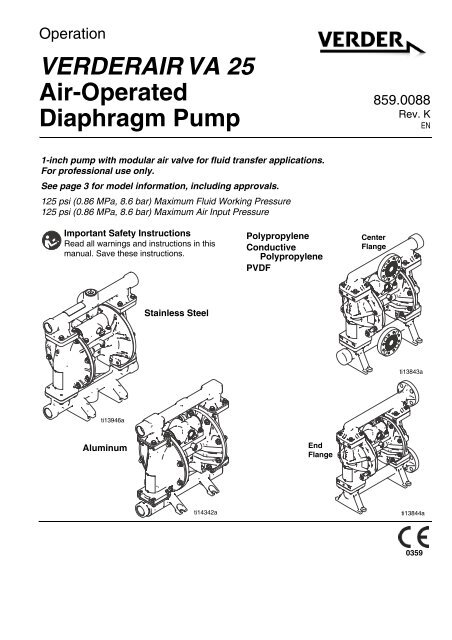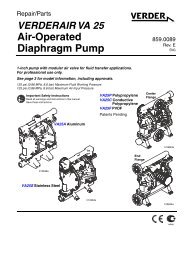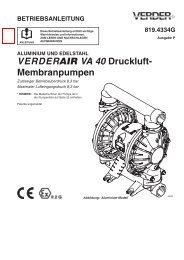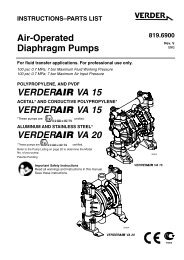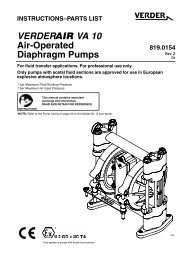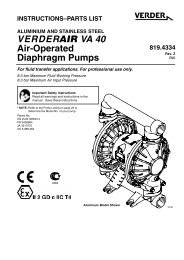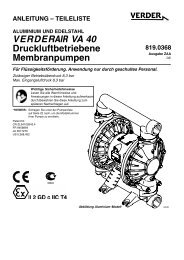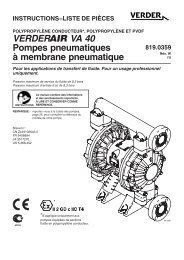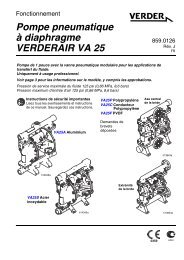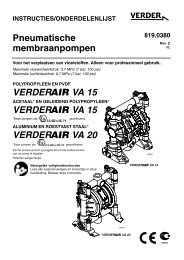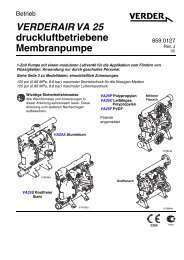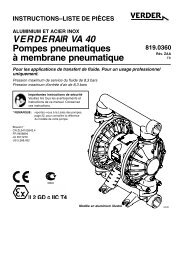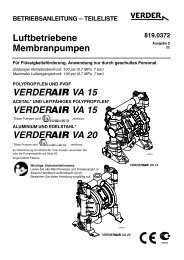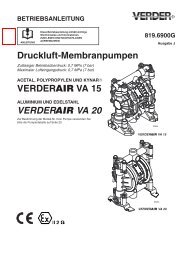VERDERAIR VA 25 Air-Operated Diaphragm Pump
Operations Manual - Double Diaphragm Pump
Operations Manual - Double Diaphragm Pump
- No tags were found...
Create successful ePaper yourself
Turn your PDF publications into a flip-book with our unique Google optimized e-Paper software.
Operation<br />
<strong>VERDERAIR</strong> <strong>VA</strong> <strong>25</strong><br />
<strong>Air</strong>-<strong>Operated</strong><br />
<strong>Diaphragm</strong> <strong>Pump</strong><br />
859.0088<br />
Rev. K<br />
EN<br />
1-inch pump with modular air valve for fluid transfer applications.<br />
For professional use only.<br />
See page 3 for model information, including approvals.<br />
1<strong>25</strong> psi (0.86 MPa, 8.6 bar) Maximum Fluid Working Pressure<br />
1<strong>25</strong> psi (0.86 MPa, 8.6 bar) Maximum <strong>Air</strong> Input Pressure<br />
Important Safety Instructions<br />
Read all warnings and instructions in this<br />
manual. Save these instructions.<br />
Polypropylene<br />
Conductive<br />
Polypropylene<br />
PVDF<br />
Center<br />
Flange<br />
Stainless Steel<br />
ti13843a<br />
ti13946a<br />
Aluminum<br />
End<br />
Flange<br />
ti14342a<br />
ti13844a<br />
0359
Contents<br />
Related Manuals . . . . . . . . . . . . . . . . . . . . . . . . . . . 2<br />
<strong>Pump</strong> Matrix . . . . . . . . . . . . . . . . . . . . . . . . . . . . . . . 3<br />
ATEX Certifications . . . . . . . . . . . . . . . . . . . . . . . . . 4<br />
Warnings . . . . . . . . . . . . . . . . . . . . . . . . . . . . . . . . . 4<br />
Installation . . . . . . . . . . . . . . . . . . . . . . . . . . . . . . . . 6<br />
Tighten Fasteners Before Setup . . . . . . . . . . . . . 6<br />
Mounting . . . . . . . . . . . . . . . . . . . . . . . . . . . . . . . 7<br />
Grounding . . . . . . . . . . . . . . . . . . . . . . . . . . . . . . 7<br />
<strong>Air</strong> Line . . . . . . . . . . . . . . . . . . . . . . . . . . . . . . . . 8<br />
Reed Switch . . . . . . . . . . . . . . . . . . . . . . . . . . . . 8<br />
<strong>Air</strong> Exhaust Ventilation . . . . . . . . . . . . . . . . . . . . 9<br />
Fluid Supply Line . . . . . . . . . . . . . . . . . . . . . . . 10<br />
Fluid Outlet Line . . . . . . . . . . . . . . . . . . . . . . . . 10<br />
Fluid Inlet and Outlet Ports . . . . . . . . . . . . . . . . 13<br />
Fluid Pressure Relief Valve . . . . . . . . . . . . . . . . 14<br />
Operation . . . . . . . . . . . . . . . . . . . . . . . . . . . . . . . . 15<br />
Pressure Relief Procedure . . . . . . . . . . . . . . . . 15<br />
Flush the <strong>Pump</strong> Before First Use . . . . . . . . . . . 15<br />
Tighten Fasteners Before Setup . . . . . . . . . . . . 15<br />
Starting and Adjusting the <strong>Pump</strong> . . . . . . . . . . . 15<br />
<strong>Pump</strong> Shutdown . . . . . . . . . . . . . . . . . . . . . . . . 16<br />
Maintenance . . . . . . . . . . . . . . . . . . . . . . . . . . . . . . 16<br />
Maintenance Schedule . . . . . . . . . . . . . . . . . . . 16<br />
Lubrication . . . . . . . . . . . . . . . . . . . . . . . . . . . . . 16<br />
Tighten Threaded Connections . . . . . . . . . . . . . 16<br />
Flushing and Storage . . . . . . . . . . . . . . . . . . . . 16<br />
Torque Instructions . . . . . . . . . . . . . . . . . . . . . . 17<br />
Dimensions and Mounting . . . . . . . . . . . . . . . . . . 18<br />
Aluminum (<strong>VA</strong><strong>25</strong>AA) . . . . . . . . . . . . . . . . . . . . . 18<br />
Polypropylene (<strong>VA</strong><strong>25</strong>PP),<br />
Conductive Polypropylene (<strong>VA</strong><strong>25</strong>CC),<br />
and PVDF (<strong>VA</strong><strong>25</strong>KP), Center Flange . . . . . 19<br />
Polypropylene (<strong>VA</strong><strong>25</strong>PP),<br />
Conductive Polypropylene (<strong>VA</strong><strong>25</strong>CC),<br />
and PVDF (<strong>VA</strong><strong>25</strong>KP), End Flange . . . . . . . 20<br />
Stainless Steel (<strong>VA</strong><strong>25</strong>SA, <strong>VA</strong><strong>25</strong>SC,<br />
and <strong>VA</strong><strong>25</strong>SP) . . . . . . . . . . . . . . . . . . . . . . . 21<br />
Performance Charts . . . . . . . . . . . . . . . . . . . . . . . . 22<br />
Technical Data . . . . . . . . . . . . . . . . . . . . . . . . . . . . 23<br />
Customer Services/Guarantee . . . . . . . . . . . . . . . 27<br />
Related Manuals<br />
Manual<br />
Description<br />
859.0089 <strong>VERDERAIR</strong> <strong>VA</strong> <strong>25</strong> <strong>Air</strong>-<strong>Operated</strong><br />
<strong>Diaphragm</strong> <strong>Pump</strong>,<br />
Repair/Parts<br />
2 859.0088
PART NO.<br />
CONFIGURATION NO.<br />
DATE CODE SERIES MAX WPR PSI-bar MADE IN<br />
SERIAL NO.<br />
<strong>Pump</strong> Matrix<br />
Check the identification plate (ID) for the 17-digit Configuration Number of<br />
your pump. Use the following matrix to define the components of your<br />
pump.<br />
Sample Configuration Number: <strong>VA</strong><strong>25</strong>AA-SSBNBNTB00<br />
<strong>VA</strong><strong>25</strong> A A SS BN BN TB 00<br />
<strong>Pump</strong><br />
Model<br />
Fluid<br />
Section<br />
<strong>Air</strong><br />
Section<br />
Seats Balls <strong>Diaphragm</strong>s Connections Options<br />
NOTE: Some combinations are not possible. Please check with your local supplier<br />
or the pump configurator on www.verderair.com.<br />
<strong>Pump</strong> ID<br />
<strong>Pump</strong> Fluid Section<br />
Check Valve Material<br />
Model Material <strong>Air</strong> Section Material<br />
Check Valve Balls<br />
<strong>VA</strong><strong>25</strong> A Aluminum★ A Aluminum AC Acetal AC Acetal<br />
C<br />
Conductive<br />
Polypropylene★ C Conductive AL Aluminum BN Buna-N<br />
Polypropylene<br />
K PVDF P Polypropylene BN Buna-N GE Geolast<br />
P Polypropylene GE Geolast ® HY TPE<br />
S<br />
Stainless Steel★<br />
★ See ATEX Certifications, page 4.<br />
HY TPE NE Polychloroprene<br />
Standard<br />
KY PVDF NW Polychloroprene<br />
Weighted<br />
PP Polypropylene SP Santoprene<br />
SP Santoprene ® SS 316 Stainless Steel<br />
SS 316 Stainless Steel TF PTFE<br />
VT FKM Fluoroelastomer VT FKM Fluoroelastomer<br />
<strong>Diaphragm</strong> Connections Options<br />
BN Buna-N FC Center Flange, DIN/ANSI 00 Standard<br />
GE Geolast FE End Flange, DIN/ANSI RE Remote<br />
HY TPE TB Threaded BSP SS Stroke Sensor ✖<br />
NO Polychloroprene Overmolded TN Threaded NPT UL UL-Listed<br />
SP Santoprene ✖ See ATEX Certifications, page 4.<br />
TF PTFE/EPDM Two-Piece<br />
TO PTFE/EPDM Overmolded<br />
VT FKM Fluoroelastomer<br />
ti14103a<br />
859.0088 3
ATEX Certifications<br />
★ All <strong>VA</strong><strong>25</strong>AA, <strong>VA</strong><strong>25</strong>CC, <strong>VA</strong><strong>25</strong>SA, and <strong>VA</strong><strong>25</strong>SC<br />
pumps are certified:<br />
II 2 GD c IIC T4<br />
✖ Stroke Sensor is certified:<br />
EEx ia IIA T3<br />
Nemko06ATEX1124<br />
II 1 G<br />
Warnings<br />
The following warnings are for the setup, use, grounding, maintenance, and repair of this equipment.<br />
The exclamation point symbol alerts you to a general warning and the hazard symbol refers<br />
to procedure-specific risk. When these symbols appear in the body of this manual, refer back to<br />
these warnings. Additional, product-specific warnings may be found throughout the body of this<br />
manual where applicable.<br />
WARNING<br />
FIRE AND EXPLOSION HAZARD<br />
Flammable fumes, such as solvent and paint fumes, in work area can ignite or<br />
explode. To help prevent fire and explosion:<br />
• Use equipment only in well ventilated area.<br />
• Eliminate all ignition sources; such as pilot lights, cigarettes, portable electric<br />
lamps, and plastic drop cloths (potential static arc).<br />
• Keep work area free of debris, including solvent, rags and gasoline.<br />
• Do not plug or unplug power cords, or turn power or light switches on or off when<br />
flammable fumes are present.<br />
• Ground all equipment in the work area. See Grounding instructions.<br />
• Use only grounded hoses.<br />
• Hold gun firmly to side of grounded pail when triggering into pail.<br />
• If there is static sparking or you feel a shock, stop operation immediately. Do not<br />
use equipment until you identify and correct the problem.<br />
• Keep a working fire extinguisher in the work area.<br />
Static charge may build up on plastic parts during cleaning and could discharge and<br />
ignite flammable materials and gases. To help prevent fire and explosion:<br />
• Clean plastic parts in a well ventilated area.<br />
• Do not clean with a dry cloth.<br />
• Do not operate electrostatic guns in equipment work area.<br />
4 859.0088
WARNING<br />
EQUIPMENT MISUSE HAZARD<br />
Misuse can cause death or serious injury.<br />
• Do not operate the unit when fatigued or under the influence of drugs or alcohol.<br />
• Do not exceed the maximum working pressure or temperature rating of the lowest<br />
rated system component. See Technical Data in all equipment manuals.<br />
• Use fluids and solvents that are compatible with equipment wetted parts. See<br />
Technical Data in all equipment manuals. Read fluid and solvent manufacturer’s<br />
warnings. For complete information about your material, request MSDS from distributor<br />
or retailer.<br />
• Do not leave the work area while equipment is energized or under pressure. Turn<br />
off all equipment and follow the Pressure Relief Procedure in this manual when<br />
equipment is not in use.<br />
• Check equipment daily. Repair or replace worn or damaged parts immediately with<br />
genuine manufacturer’s replacement parts only.<br />
• Do not alter or modify equipment.<br />
• Use equipment only for its intended purpose. Call your distributor for information.<br />
• Route hoses and cables away from traffic areas, sharp edges, moving parts, and<br />
hot surfaces.<br />
• Do not kink or over bend hoses or use hoses to pull equipment.<br />
• Keep children and animals away from work area.<br />
• Comply with all applicable safety regulations.<br />
PRESSURIZED EQUIPMENT HAZARD<br />
Fluid from the gun/dispense valve, leaks, or ruptured components can splash in the<br />
eyes or on skin and cause serious injury.<br />
• Follow Pressure Relief Procedure in this manual, when you stop spraying and<br />
before cleaning, checking, or servicing equipment.<br />
• Tighten all fluid connections before operating the equipment.<br />
• Check hoses, tubes, and couplings daily. Replace worn or damaged parts immediately.<br />
THERMAL EXPANSION HAZARD<br />
Fluids subjected to heat in confined spaces, including hoses, can create a rapid rise in<br />
pressure due to the thermal expansion. Over-pressurization can result in equipment<br />
rupture and serious injury.<br />
• Open a valve to relieve the fluid expansion during heating.<br />
• Replace hoses proactively at regular intervals based on your operating conditions.<br />
859.0088 5
WARNING<br />
PRESSURIZED ALUMINUM PARTS HAZARD<br />
Use of fluids that are incompatible with aluminum in pressurized equipment can cause<br />
serious chemical reaction and equipment rupture. Failure to follow this warning can<br />
result in death, serious injury, or property damage.<br />
• Do not use 1,1,1-trichloroethane, methylene chloride, other halogenated<br />
hydrocarbon solvents or fluids containing such solvents.<br />
• Many other fluids may contain chemicals that can react with aluminum. Contact<br />
your material supplier for compatibility.<br />
PLASTIC PARTS CLEANING SOLVENT HAZARD<br />
Use only compatible water-based solvents to clean plastic structural or pressure-containing<br />
parts. Many solvents can degrade plastic parts and cause them to fail, which<br />
could cause serious injury or property damage. See Technical Data in this and all<br />
other equipment instruction manuals. Read fluid and solvent manufacturer’s warnings.<br />
TOXIC FLUID OR FUMES HAZARD<br />
Toxic fluids or fumes can cause serious injury or death if splashed in the eyes or on<br />
skin, inhaled, or swallowed.<br />
• Read MSDS’s to know the specific hazards of the fluids you are using.<br />
• Route exhaust away from work area. If diaphragm ruptures, fluid may be exhausted<br />
with air.<br />
• Store hazardous fluid in approved containers, and dispose of it according to applicable<br />
guidelines.<br />
• Always wear impervious gloves when spraying or cleaning equipment.<br />
BURN HAZARD<br />
Equipment surfaces and fluid that’s heated can become very hot during operation. To<br />
avoid severe burns:<br />
• Do not touch hot fluid or equipment.<br />
• Wait until equipment/fluid has cooled completely.<br />
PERSONAL PROTECTIVE EQUIPMENT<br />
You must wear appropriate protective equipment when operating, servicing, or when in<br />
the operating area of the equipment to help protect you from serious injury, including<br />
eye injury, inhalation of toxic fumes, burns, and hearing loss. This equipment includes<br />
but is not limited to:<br />
• Clothing and respirator as recommended by the fluid and solvent manufacturer<br />
• Protective eyewear, gloves, and hearing protection<br />
6 859.0088
Installation<br />
The Typical Installations shown in FIG. 4 and<br />
FIG. 5 are only guides for selecting and installing<br />
system components. Contact your distributor<br />
for assistance in planning a system to suit<br />
your needs.<br />
Tighten Fasteners Before Setup<br />
Before using the pump for the first time, check<br />
and retorque all external fasteners. Follow<br />
Torque Instructions, page 17.<br />
Mounting<br />
• The pump exhaust air may contain contaminants.<br />
Ventilate to a remote area. See<br />
<strong>Air</strong> Exhaust Ventilation on page 9.<br />
• Never move or lift a pump under pressure.<br />
If dropped, the fluid section may rupture.<br />
Always follow the Pressure Relief Procedure<br />
on page 15 before moving or lifting<br />
the pump.<br />
1. For wall mounting, order Kit 859.0107.<br />
2. Be sure the mounting surface can support<br />
the weight of the pump, hoses, and accessories,<br />
as well as the stress caused during<br />
operation.<br />
Grounding<br />
The equipment must be grounded. Grounding<br />
reduces the risk of static and electric<br />
shock by providing an escape wire for the<br />
electrical current due to static build up or in<br />
the event of a short circuit.<br />
<strong>Pump</strong>: See FIG. 1. Loosen the grounding screw<br />
(GS). Insert one end of a 12 ga. minimum<br />
ground wire (R) behind the grounding screw<br />
and tighten the screw securely. Connect the<br />
clamp end of the ground wire to a true earth<br />
ground. A ground wire and clamp, Part<br />
819.0157, is available.<br />
Polypropylene and PVDF: Only aluminum,<br />
conductive polypropylene, and stainless steel<br />
pumps have a ground screw. Standard polypropylene<br />
and PVDF pumps are not conductive.<br />
Never use a non-conductive<br />
polypropylene or PVDF pump with non-conductive<br />
flammable fluids. Follow your local<br />
fire codes. When pumping conductive flammable<br />
fluids, always ground the entire fluid<br />
system as described.<br />
3. For all mountings, be sure the pump is<br />
bolted directly to the mounting surface.<br />
4. For ease of operation and service, mount<br />
the pump so air valve, air inlet, fluid inlet and<br />
fluid outlet ports are easily accessible.<br />
5. Rubber Foot Mounting Kit 819.4333 is available<br />
to reduce noise and vibration during<br />
operation.<br />
GS<br />
FIG. 1. Grounding screw and wire<br />
R<br />
ti12214a<br />
859.0088 7
<strong>Air</strong> and fluid hoses: Use only grounded<br />
hoses with a maximum of 500 ft (150 m) combined<br />
hose length to ensure grounding continuity.<br />
<strong>Air</strong> compressor: Follow manufacturer’s<br />
recommendations.<br />
Fluid supply container: Follow local code.<br />
Solvent pails used when flushing: Follow<br />
local code. Use only conductive metal pails,<br />
placed on a grounded surface. Do not place<br />
the pail on a nonconductive surface, such as<br />
paper or cardboard, which interrupts grounding<br />
continuity.<br />
Check your system electrical continuity after<br />
the initial installation, and then set up a regular<br />
schedule for checking continuity to be sure<br />
proper grounding is maintained.<br />
<strong>Air</strong> Line<br />
See FIG. 4 and FIG. 5, pages 11 and 12.<br />
1. Install an air filter/regulator assembly (C) to<br />
control the fluid pressure and remove<br />
harmful dirt and moisture from the compressed<br />
air supply. The fluid stall pressure<br />
will be the same as the setting of the air<br />
regulator.<br />
2. Locate a bleed-type master air valve (B)<br />
close to the pump and use it to relieve<br />
trapped air. Be sure the valve is easily<br />
accessible from the pump and located<br />
downstream from the regulator.<br />
3. Locate another master air valve (E)<br />
upstream from all air line accessories and<br />
use it to isolate them during cleaning and<br />
repair.<br />
4. Install a grounded, flexible air hose (A)<br />
between the accessories and the 1/2 npt(f)<br />
pump air inlet (D). Use a minimum 3/8 in.<br />
(10 mm) ID air hose.<br />
Installation of Remote Pilot <strong>Air</strong> Lines<br />
NOTICE<br />
Pilot supply pressure should not exceed<br />
<strong>25</strong>-50% of main air supply pressure. If pilot<br />
supply pressure is too high, the pump could<br />
leak air or exhaust excessive air at stall.<br />
1. Connect an air supply line to the pump (A,<br />
FIG. 3, page 9).<br />
2. Insert 5/32 OD tubing into the push-to-connect<br />
fitting on each pilot valve (113).<br />
3. Connect remaining ends of tubes to external<br />
air signal, such as the CycleFlo (PN<br />
819.9742) or CycleFlo II (PN 819.9743)<br />
controllers.<br />
113<br />
Trapped air can cause the pump to cycle<br />
unexpectedly, which could result in serious<br />
injury from splashing.<br />
CycleFlo<br />
FIG. 2. Connect Remote <strong>Air</strong> Control<br />
113<br />
ti16894a<br />
8 859.0088
Reed Switch<br />
Stroke Sensor kits are available for use with<br />
customer-supplied fluid management or inventory<br />
tracking systems. Attach an M12, 5-pin<br />
female cable to connect the reed switch to your<br />
data monitoring system. See Manual 859.0099.<br />
<strong>Air</strong> Exhaust Ventilation<br />
The air exhaust port is 3/4 npt(f). Do not restrict<br />
the air exhaust port. Excessive exhaust restriction<br />
can cause erratic pump operation.<br />
A<br />
To provide a remote exhaust:<br />
1. Remove the muffler (T) from the pump air<br />
exhaust port.<br />
2. Install a grounded air exhaust hose (U) and<br />
connect the muffler (T) to the other end of<br />
the hose. The minimum size for the air<br />
exhaust hose is 3/4 in. (19 mm) ID. If a hose<br />
longer than 15 ft (4.57 m) is required, use a<br />
larger diameter hose. Avoid sharp bends or<br />
kinks in the hose.<br />
3. Place a container at the end of the air<br />
exhaust line to catch fluid in case a diaphragm<br />
ruptures. If the diaphragm ruptures,<br />
the fluid being pumped will exhaust with the<br />
air.<br />
Key:<br />
A <strong>Air</strong> supply line<br />
B Bleed-type master air valve<br />
C <strong>Air</strong> filter/regulator assembly<br />
D <strong>Air</strong> inlet<br />
E Master air valve (for accessories)<br />
T Muffler<br />
U Grounded air exhaust hose<br />
V Container for remote air exhaust<br />
U<br />
V<br />
E C B<br />
D<br />
T<br />
FIG. 3. Vent exhaust air<br />
ti14219b<br />
859.0088 9
Fluid Supply Line<br />
See FIG. 4 and FIG. 5, pages 11 and 12.<br />
1. Use grounded fluid supply lines (G). See<br />
Grounding, page 7.<br />
2. If the inlet fluid pressure to the pump is<br />
more than <strong>25</strong>% of the outlet working pressure,<br />
the ball check valves will not close<br />
fast enough, resulting in inefficient pump<br />
operation. Excessive inlet fluid pressure<br />
also will shorten diaphragm life. Approximately<br />
3 - 5 psi (0.02- 0.03 MPa,<br />
0.21-0.34 bar) should be adequate for most<br />
materials.<br />
Fluid Outlet Line<br />
See FIG. 4 and FIG. 5, pages 11 and 12.<br />
1. Use grounded, flexible fluid hoses (L). See<br />
Grounding, page 7.<br />
2. Install a fluid drain valve (J) near the fluid<br />
outlet.<br />
3. Install a shutoff valve (K) in the fluid outlet<br />
line.<br />
3. At inlet fluid pressures greater than 15 psi<br />
(0.1 MPa, 1 bar), diaphragm life will be<br />
shortened.<br />
4. For maximum suction lift (wet and dry), see<br />
Technical Data, page 23. For best results,<br />
always install the pump as close as possible<br />
to the material source.<br />
10 859.0088
E<br />
B<br />
A<br />
N<br />
K<br />
L<br />
C<br />
D<br />
M<br />
J<br />
R<br />
H<br />
M<br />
G<br />
FIG. 4. Typical bung-mount installation (aluminum pump shown)<br />
ti14163b<br />
859.0088 11
A<br />
E<br />
B<br />
N<br />
K<br />
L<br />
C<br />
D<br />
J<br />
R<br />
G<br />
M<br />
ti14164b<br />
FIG. 5. Typical floor-mount installation (polypropylene pump shown)<br />
Key for FIG. 4 and FIG. 5:<br />
A<br />
B<br />
C<br />
D<br />
E<br />
G<br />
J<br />
K<br />
L<br />
M<br />
<strong>Air</strong> supply line<br />
Bleed-type master air valve (required for pump)<br />
<strong>Air</strong> filter/regulator assembly<br />
<strong>Air</strong> inlet<br />
Master air valve (for accessories)<br />
Grounded, flexible fluid supply line<br />
Fluid drain valve (required)<br />
Fluid shutoff valve<br />
Grounded, flexible fluid outlet line<br />
Fluid inlet (Aluminum, FIG. 4, four ports, one<br />
not visible; Plastic, FIG. 5, center or end flanges<br />
available; Stainless Steel, not pictured, one<br />
port)<br />
N<br />
R<br />
Fluid outlet (Aluminum, FIG. 4, four ports, one<br />
not visible; Plastic, FIG. 5, center or end flanges<br />
available; Stainless Steel, not pictured, one<br />
port)<br />
Ground wire (required for aluminum,<br />
conductive polypropylene, and stainless steel<br />
pumps; see page 7 for installation instructions)<br />
12 859.0088
Fluid Inlet and Outlet Ports<br />
NOTE: Remove and reverse the manifold(s) to<br />
change the orientation of inlet or outlet port(s).<br />
Follow Torque Instructions on page 17.<br />
Aluminum (<strong>VA</strong><strong>25</strong>AA)<br />
The fluid inlet and outlet manifolds each have<br />
four 1 in. npt(f) or bspt threaded ports (FIG. 4,<br />
M, N). Close off the unused ports, using the<br />
supplied plugs.<br />
Plastic (<strong>VA</strong><strong>25</strong>PP, <strong>VA</strong><strong>25</strong>CC, and <strong>VA</strong><strong>25</strong>KP)<br />
The fluid inlet and outlet manifolds each have a<br />
1 in. raised face ANSI/DIN flange (FIG. 5, M, N)<br />
in either a center or end location. Connect 1 in.<br />
standard flanged plastic pipe to the pump.<br />
See FIG. 6.<br />
Standard pipe flange kits are available in polypropylene<br />
(819.6885), stainless steel<br />
(819.6886), and PVDF (819.6887). These kits<br />
include:<br />
• the pipe flange<br />
• a PTFE gasket<br />
• four 1/2 in. bolts, spring lock washers,<br />
flat washers and nuts.<br />
Be sure to lubricate the threads of the bolts and<br />
torque to 10-15 ft-lb (14-20 N•m). Follow the<br />
bolt tightening sequence and do not<br />
over-torque.<br />
Stainless Steel (<strong>VA</strong><strong>25</strong>SA, <strong>VA</strong><strong>25</strong>SC)<br />
The fluid inlet and outlet manifolds each have<br />
one 1 in. npt (f) or bspt threaded port.<br />
Bolt tightening sequence<br />
<br />
<br />
<br />
3<br />
1<br />
<br />
<br />
<br />
<br />
<br />
2<br />
4<br />
ti14182a<br />
<br />
ti14181ba<br />
Key:<br />
M 1 in. fluid inlet flange<br />
N 1 in. fluid outlet flange<br />
S 1 in. standard pipe flange<br />
T PTFE gasket<br />
U Flat washer<br />
V Nut<br />
W Lock washer<br />
X Bolt<br />
1<br />
Torque to 10-15 ft-lb (14-20 N•m). Do<br />
not over-torque.<br />
FIG. 6. Flange connections (plastic pumps only, <strong>VA</strong><strong>25</strong>PP, <strong>VA</strong><strong>25</strong>CC, and <strong>VA</strong><strong>25</strong>KP models)<br />
859.0088 13
Fluid Pressure Relief Valve<br />
Some systems may require installation of a<br />
pressure relief valve at the pump outlet to prevent<br />
overpressurization and rupture of the<br />
pump or hose.<br />
Thermal expansion of fluid in the outlet line<br />
can cause overpressurization. Thermal<br />
expansion can occur when using long fluid<br />
lines exposed to sunlight or ambient heat, or<br />
when pumping from a cool to a warm area (for<br />
example, from an underground tank).<br />
Overpressurization also can occur if the pump<br />
is used to feed fluid to a piston pump, and the<br />
intake valve of the piston pump does not<br />
close, causing fluid to back up in the outlet<br />
line.<br />
FIG. 7 shows Fluid Pressure Relief Kit<br />
819.6479 for aluminum pumps. Use Fluid<br />
Pressure Relief Kit 819.0159, not shown, for<br />
plastic pumps.<br />
<br />
<br />
1<br />
2<br />
3<br />
Apply thread sealant on threaded connections<br />
and install kit between fluid inlet and<br />
outlet manifolds.<br />
Connect fluid inlet line in one of the<br />
optional ports.<br />
Connect fluid outlet line in one of the<br />
optional ports.<br />
<br />
<br />
<br />
ti14214b<br />
FIG. 7. Fluid pressure relief kit (Aluminum pumps only, <strong>VA</strong><strong>25</strong>AA models)<br />
14 859.0088
Operation<br />
Pressure Relief Procedure<br />
Trapped air can cause the pump to cycle<br />
unexpectedly, which could result in serious<br />
injury from splashing.<br />
1. Shut off the air supply to the pump.<br />
2. Open the dispensing valve, if used.<br />
3. Open the fluid drain valve to relieve fluid<br />
pressure. Have a container ready to catch<br />
the drainage.<br />
Flush the <strong>Pump</strong> Before First Use<br />
The pump was tested in water. If water could<br />
contaminate the fluid you are pumping, flush<br />
the pump thoroughly with a compatible solvent.<br />
See Tighten Threaded Connections, page<br />
16.<br />
Tighten Fasteners Before Setup<br />
Before using the pump for the first time, check<br />
and retorque all external fasteners. Follow<br />
Torque Instructions, page 17. After the first<br />
day of operation, retorque the fasteners.<br />
Starting and Adjusting the <strong>Pump</strong><br />
1. Be sure the pump is properly grounded.<br />
Refer to Grounding on page 7.<br />
2. Check fittings to be sure they are tight. Use<br />
a compatible liquid thread sealant on male<br />
threads. Tighten fluid inlet and outlet fittings<br />
securely.<br />
NOTE: If fluid inlet pressure to the pump is<br />
more than <strong>25</strong>% of outlet working pressure, the<br />
ball check valves will not close fast enough,<br />
resulting in inefficient pump operation.<br />
4. Place the end of the fluid hose into an<br />
appropriate container.<br />
5. Close the fluid drain valve.<br />
6. Back out the air regulator knob, and open all<br />
bleed-type master air valves.<br />
7. If the fluid hose has a dispensing device,<br />
hold it open.<br />
8. Slowly increase air pressure with the air regulator<br />
until the pump starts to cycle. Allow<br />
the pump to cycle slowly until all air is<br />
pushed out of the lines and the pump is<br />
primed.<br />
NOTE: Use lowest possible air pressure to<br />
prime, just enough to cycle the pump. If the<br />
pump does not prime as expected, turn air<br />
pressure DOWN.<br />
NOTICE<br />
When replacing old models of <strong>VA</strong> <strong>25</strong>: The<br />
new <strong>VA</strong> <strong>25</strong> operates more efficiently than did<br />
the old models. Reduce air inlet pressure by<br />
approximately 20 percent to maintain an<br />
equivalent fluid output.<br />
9. If you are flushing, run the pump long<br />
enough to thoroughly clean the pump and<br />
hoses.<br />
10.Close the dispensing valve, if used.<br />
11.Close the bleed-type master air valve.<br />
3. Place the suction tube (if used) in fluid to be<br />
pumped.<br />
859.0088 15
<strong>Pump</strong> Shutdown<br />
Flushing and Storage<br />
At the end of the work shift and before you<br />
check, adjust, clean or repair the system, follow<br />
Pressure Relief Procedure, page 15.<br />
Maintenance<br />
Maintenance Schedule<br />
Establish a preventive maintenance schedule,<br />
based on the pump’s service history. Scheduled<br />
maintenance is especially important to<br />
prevent spills or leakage due to diaphragm<br />
failure.<br />
Lubrication<br />
The pump is lubricated at the factory. It is<br />
designed to require no further lubrication for<br />
the life of the pump.<br />
• Flush before fluid can dry in the equipment,<br />
at the end of the day, before storing, and<br />
before repairing equipment.<br />
• Flush at the lowest pressure possible.<br />
Check connectors for leaks and tighten as<br />
necessary.<br />
• Flush with a fluid that is compatible with the<br />
fluid being dispensed and the equipment<br />
wetted parts.<br />
Flush the pump often enough to prevent the<br />
fluid you are pumping from drying or freezing<br />
in the pump and damaging it. Use a compatible<br />
solvent.<br />
Always flush the pump and relieve the pressure<br />
before storing it for any length of time.<br />
Tighten Threaded Connections<br />
Before each use, check all hoses for wear or<br />
damage and replace as necessary. Check to<br />
be sure all threaded connections are tight and<br />
leak-free. Check fasteners. Tighten or retorque<br />
as necessary. Although pump use varies, a<br />
general guideline is to retorque fasteners<br />
every two months. See Torque Instructions,<br />
page 17.<br />
16 859.0088
Torque Instructions<br />
NOTE: Fluid cover and manifold fasteners<br />
have a thread-locking adhesive patch applied<br />
to the threads. If this patch is excessively<br />
worn, the fasteners may loosen during operation.<br />
Replace screws with new ones or<br />
apply medium-strength (blue) Loctite or<br />
equivalent to the threads.<br />
<br />
<br />
<br />
<br />
If fluid cover or manifold fasteners have been<br />
loosened, it is important to torque them using<br />
the following procedure to improve sealing.<br />
<br />
<br />
<br />
<br />
NOTE: Always completely torque fluid covers<br />
before torquing manifolds.<br />
ti18448a<br />
Start all fluid cover screws a few turns. Then<br />
turn down each screw just until head contacts<br />
cover. Then turn each screw by 1/2 turn<br />
or less working in a crisscross pattern to<br />
specified torque. Repeat for manifolds.<br />
<br />
<br />
<br />
<br />
Fluid cover and manifold fasteners:<br />
100 in-lb (11.3 N•m)<br />
Retorque the air valve fasteners (V) in a<br />
crisscross pattern to specified torque.<br />
<br />
<br />
<br />
<br />
<br />
ti18449a<br />
Plastic center sections: 55 in-lb (6.2 N•m)<br />
Metal center sections: 80 in-lb (9.0 N•m)<br />
FIG. 8. Torque sequence<br />
859.0088 17
Dimensions and Mounting<br />
Aluminum (<strong>VA</strong><strong>25</strong>AA)<br />
G<br />
<br />
F<br />
<br />
<br />
A<br />
<br />
D<br />
<br />
E<br />
<br />
ti12212b<br />
ti12211b<br />
H<br />
J<br />
K<br />
5.0 in.<br />
(127 mm)<br />
ti12213b<br />
5.5 in.<br />
(140 mm)<br />
ti14540b<br />
A ..... 12.7 in. (323 mm)<br />
B ..... 14.4 in. (366 mm)<br />
C ..... 15.9 in. (404 mm)<br />
D ..... 10.9 in. (277 mm)<br />
E...... 1.8 in. (46 mm)<br />
F...... 7.3 in. (185 mm)<br />
G ..... 14.7 in. (373 mm)<br />
H ..... 6.2 in. (158 mm)<br />
J ..... 3.9 in. (99 mm)<br />
K..... 10.2 in. (<strong>25</strong>8 mm)<br />
L ..... 1/2 npt(f) air inlet<br />
M....1 in. npt(f) or 1 in. bspt fluid<br />
inlet ports (4)<br />
N..... 1 in. npt(f) or 1 in. bspt fluid<br />
outlet ports (4)<br />
P..... 3/4 npt(f) air exhaust port<br />
18 859.0088
Polypropylene (<strong>VA</strong><strong>25</strong>PP), Conductive Polypropylene (<strong>VA</strong><strong>25</strong>CC), and<br />
PVDF (<strong>VA</strong><strong>25</strong>KP), Center Flange<br />
<br />
<br />
<br />
<br />
<br />
<br />
<br />
<br />
<br />
<br />
<br />
ti13845b<br />
ti13847b<br />
<br />
<br />
<br />
<br />
<br />
ti13846b<br />
<br />
<br />
ti14541b<br />
A..... 13.2 in. (335 mm)<br />
B..... 15.7 in. (399 mm)<br />
C..... 17.8 in. (452 mm)<br />
D..... 12.0 in. (305 mm)<br />
E..... 2.5 in. (63.5 mm)<br />
F ..... 8.0 in. (203 mm)<br />
G....16.0 in. (406 mm)<br />
H..... 6.2 in. (158 mm)<br />
J ..... 3.9 in. (99 mm)<br />
K..... 10.2 in. (<strong>25</strong>8 mm)<br />
L ..... 1/2 npt(f) air inlet<br />
M....1 in. ANSI/DIN flange<br />
N..... 1 in. ANSI/DIN flange<br />
P..... 3/4 npt(f) air exhaust port<br />
859.0088 19
Polypropylene (<strong>VA</strong><strong>25</strong>PP), Conductive Polypropylene (<strong>VA</strong><strong>25</strong>CC), and<br />
PVDF (<strong>VA</strong><strong>25</strong>KP), End Flange<br />
<br />
<br />
<br />
<br />
<br />
<br />
<br />
<br />
<br />
<br />
<br />
ti14820a<br />
ti14823a<br />
<br />
<br />
<br />
<br />
<br />
ti14821a<br />
<br />
<br />
ti14822<br />
A ..... 13.2 in. (335 mm)<br />
B ..... 15.7 in. (399 mm)<br />
C ..... 17.8 in. (452 mm)<br />
D ..... 12.0 in. (305 mm)<br />
E...... 2.5 in. (63.5 mm)<br />
F...... 8.0 in. (203 mm)<br />
G ..... 15.2 in. (386 mm)<br />
H..... 6.2 in. (158 mm)<br />
J ..... 3.9 in. (99 mm)<br />
K..... 10.2 in. (<strong>25</strong>8 mm)<br />
L ..... 1/2 npt(f) air inlet<br />
M....1 in. ANSI/DIN flange<br />
N..... 1 in. ANSI/DIN flange<br />
P..... 3/4 npt(f) air exhaust port<br />
20 859.0088
Stainless Steel (<strong>VA</strong><strong>25</strong>SA, <strong>VA</strong><strong>25</strong>SC, and <strong>VA</strong><strong>25</strong>SP)<br />
<br />
<br />
<br />
<br />
<br />
<br />
<br />
<br />
<br />
ti14343b<br />
ti14344b<br />
<br />
<br />
<br />
<br />
<br />
ti14345b<br />
<br />
<br />
ti14345b<br />
ti14542b<br />
A..... 11.8 in. (300 mm)<br />
B..... 12.9 in. (328 mm)<br />
C..... 13.7 in. (348 mm)<br />
D..... 9.5 in. (241 mm)<br />
E..... 1.1 in. (28 mm)<br />
G....13.9 in. (353 mm)<br />
H..... 6.2 in. (158 mm)<br />
J ..... 4.0 in. (102 mm)<br />
K..... 10.2 in. (<strong>25</strong>8 mm)<br />
L ..... 1/2 npt(f) air inlet<br />
M....1 in. npt(f) or 1 in. bspt fluid inlet<br />
ports (4)<br />
N..... 1 in. npt(f) or 1 in. bspt fluid outlet<br />
ports (4)<br />
P..... 3/4 npt(f) air exhaust port<br />
859.0088 21
Performance Charts<br />
Test Conditions: <strong>Pump</strong> tested in water with inlet submerged.<br />
Cycle Rate<br />
28 56 84 112 140 168 196 224 <strong>25</strong>2 280<br />
Operating <strong>Air</strong> Pressure<br />
A<br />
1<strong>25</strong> psi (0.83 MPa, 8.3 bar)<br />
B<br />
100 psi (0.7 MPa, 7.0 bar)<br />
C<br />
70 psi (0.48 MPa, 4.8 bar)<br />
D<br />
40 psi (0.28 MPa, 2.8 bar)<br />
Fluid Pressure - psi (MPa, bar)<br />
120<br />
(0.83. 8.3)<br />
100<br />
(0.7, 7.0)<br />
80<br />
(0.55, 5.5)<br />
60<br />
(0.41, 4.1)<br />
40<br />
(0.28, 2.8)<br />
20<br />
(0.14, 1.4)<br />
0<br />
A<br />
Fluid Pressure<br />
B<br />
C<br />
D<br />
0 5 10 15 20 <strong>25</strong> 30 35 40 45 50<br />
(19) (38) (57) (76) (95) (114) (133) (152) (170) (189)<br />
Fluid Flow — gpm (lpm)<br />
How to Read the Charts<br />
1. Locate fluid flow rate along<br />
bottom of chart.<br />
2. Follow vertical line up to<br />
intersection with selected<br />
operating air pressure<br />
curve.<br />
3. Follow left to scale to read<br />
fluid outlet pressure<br />
(top chart) or<br />
air consumption<br />
(bottom chart).<br />
<strong>Air</strong> Consumption - scfm (cubic meters/min.)<br />
80<br />
(2.24)<br />
60<br />
(1.68)<br />
40<br />
(1.12)<br />
20<br />
(0.56)<br />
0<br />
Cycle Rate<br />
28 56 84 112 140 168 196 224 <strong>25</strong>2 280<br />
<strong>Air</strong> Consumption<br />
0 5 10 15 20 <strong>25</strong> 30 35 40 45 50<br />
(19) (38) (57) (76) (95) (114) (133) (152) (170) (189)<br />
Fluid Flow — gpm (lpm)<br />
A<br />
B<br />
C<br />
D<br />
22 859.0088
Technical Data<br />
Maximum fluid working pressure . . . . . . . . . . . . . . . . . . . . . . . . . . . . . . . . . . . . . . . 1<strong>25</strong> psi (0.86 MPa, 8.6 bar)<br />
<strong>Air</strong> pressure operating range . . . . . . . . . . . . . . . . . . . . . . . . . . . . . . . . . . . . . . . . . . 20-1<strong>25</strong> psi (0.14-0.86 MPa, 1.4-8.6 bar)<br />
Fluid displacement per cycle . . . . . . . . . . . . . . . . . . . . . . . . . . . . . . . . . . . . . . . . . . 0.17 gal. (0.64 liters)<br />
<strong>Air</strong> consumption at 70 psi (0.48 MPa, 4.8 bar), 20 gpm (76 lpm) . . . . . . . . . . . . . . . <strong>25</strong> scfm<br />
Maximum values with water as media under submerged inlet<br />
conditions at ambient temperature:<br />
Maximum air consumption. . . . . . . . . . . . . . . . . . . . . . . . . . . . . . . . . . . . . . . . .<br />
Maximum free-flow delivery. . . . . . . . . . . . . . . . . . . . . . . . . . . . . . . . . . . . . . . .<br />
Maximum pump speed . . . . . . . . . . . . . . . . . . . . . . . . . . . . . . . . . . . . . . . . . . .<br />
Maximum suction lift . . . . . . . . . . . . . . . . . . . . . . . . . . . . . . . . . . . . . . . . . . . . .<br />
Maximum size pumpable solids . . . . . . . . . . . . . . . . . . . . . . . . . . . . . . . . . . . . . . . . 1/8 in. (3.2 mm)<br />
Recommended cycle rate for continuous use. . . . . . . . . . . . . . . . . . . . . . . . . . . . . . 93 - 140 cpm<br />
Recommended cycle rate for circulation systems . . . . . . . . . . . . . . . . . . . . . . . . . . 20 cpm<br />
Sound Power*<br />
at 70 psi (0.48 MPa, 4.8 bar) and 50 cpm . . . . . . . . . . . . . . . . . . . . . . . . . . . . .<br />
at 100 psi (0.7 MPa, 7.0 bar) and full flow. . . . . . . . . . . . . . . . . . . . . . . . . . . . .<br />
Sound Pressure**<br />
at 70 psi (0.48 MPa, 4.8 bar) and 50 cpm . . . . . . . . . . . . . . . . . . . . . . . . . . . . .<br />
at 100 psi (0.7 MPa, 7.0 bar) and full flow. . . . . . . . . . . . . . . . . . . . . . . . . . . . .<br />
* Sound power measured per ISO-9614-2.<br />
** Sound pressure was tested 3.28 ft (1 m) from equipment.<br />
All trademarks mentioned in this manual are the property of their respective owners.<br />
67 scfm<br />
50 gpm (189 lpm)<br />
280 cpm<br />
16 ft (4.9 m) dry, 29 ft (8.8 m) wet<br />
78 dBa<br />
90 dBa<br />
84 dBa<br />
96 dBa<br />
Operating temperature range . . . . . . . . . . . . . . . . . . . . . . . . . . . . . . . . . . . . . . . . . . see page 24<br />
<strong>Air</strong> inlet size . . . . . . . . . . . . . . . . . . . . . . . . . . . . . . . . . . . . . . . . . . . . . . . . . . . . . . . 1/2 npt(f)<br />
Fluid inlet size<br />
Aluminum (<strong>VA</strong><strong>25</strong>AA) . . . . . . . . . . . . . . . . . . . . . . . . . . . . . . . . . . . . . . . . . . . . .<br />
Plastic (<strong>VA</strong><strong>25</strong>PP, <strong>VA</strong><strong>25</strong>CC, and <strong>VA</strong><strong>25</strong>KP) . . . . . . . . . . . . . . . . . . . . . . . . . . . .<br />
Stainless Steel (<strong>VA</strong><strong>25</strong>SA, <strong>VA</strong><strong>25</strong>SC, and <strong>VA</strong><strong>25</strong>SP) . . . . . . . . . . . . . . . . . . . . . .<br />
Fluid outlet size<br />
Aluminum (<strong>VA</strong><strong>25</strong>AA) . . . . . . . . . . . . . . . . . . . . . . . . . . . . . . . . . . . . . . . . . . . . .<br />
Plastic (<strong>VA</strong><strong>25</strong>PP, <strong>VA</strong><strong>25</strong>CC, and <strong>VA</strong><strong>25</strong>KP) . . . . . . . . . . . . . . . . . . . . . . . . . . . .<br />
Stainless Steel (<strong>VA</strong><strong>25</strong>SA, <strong>VA</strong><strong>25</strong>SC, and <strong>VA</strong><strong>25</strong>SP) . . . . . . . . . . . . . . . . . . . . . .<br />
Weight<br />
Aluminum (<strong>VA</strong><strong>25</strong>AA) . . . . . . . . . . . . . . . . . . . . . . . . . . . . . . . . . . . . . . . . . . . . .<br />
Polypropylene and Conductive Polypropylene (<strong>VA</strong><strong>25</strong>PP and <strong>VA</strong><strong>25</strong>CC). . . . . .<br />
PVDF (<strong>VA</strong><strong>25</strong>KP) . . . . . . . . . . . . . . . . . . . . . . . . . . . . . . . . . . . . . . . . . . . . . . . .<br />
Stainless Steel<br />
with conductive polypropylene center (<strong>VA</strong><strong>25</strong>SC) . . . . . . . . . . . . . . . . . .<br />
with polypropylene center (<strong>VA</strong><strong>25</strong>SP). . . . . . . . . . . . . . . . . . . . . . . . . . . .<br />
with aluminum center (<strong>VA</strong><strong>25</strong>SA) . . . . . . . . . . . . . . . . . . . . . . . . . . . . . . .<br />
Wetted parts include material(s) chosen for seat, ball, and diaphragm options, plus<br />
the pump’s material of construction<br />
<strong>VA</strong><strong>25</strong>AA. . . . . . . . . . . . . . . . . . . . . . . . . . . . . . . . . . . . . . . . . . . . . . . . . . . . . . .<br />
<strong>VA</strong><strong>25</strong>PP and <strong>VA</strong><strong>25</strong>CC. . . . . . . . . . . . . . . . . . . . . . . . . . . . . . . . . . . . . . . . . . . .<br />
<strong>VA</strong><strong>25</strong>KP. . . . . . . . . . . . . . . . . . . . . . . . . . . . . . . . . . . . . . . . . . . . . . . . . . . . . . .<br />
<strong>VA</strong><strong>25</strong>SA, <strong>VA</strong><strong>25</strong>SC, and <strong>VA</strong><strong>25</strong>SP . . . . . . . . . . . . . . . . . . . . . . . . . . . . . . . . . . .<br />
Non-wetted external parts<br />
Aluminum (<strong>VA</strong><strong>25</strong>AA) . . . . . . . . . . . . . . . . . . . . . . . . . . . . . . . . . . . . . . . . . . . . .<br />
Plastic (<strong>VA</strong><strong>25</strong>PP, <strong>VA</strong><strong>25</strong>CC, and <strong>VA</strong><strong>25</strong>KP) . . . . . . . . . . . . . . . . . . . . . . . . . . . .<br />
Stainless Steel (<strong>VA</strong><strong>25</strong>SA, <strong>VA</strong><strong>25</strong>SC, and <strong>VA</strong><strong>25</strong>SP) . . . . . . . . . . . . . . . . . . . . . .<br />
1 in. npt(f) or 1 in. bspt<br />
1 in. raised face ANSI/DIN flange<br />
1 in. npt(f) or 1 in. bspt<br />
1 in. npt(f) or 1 in. bspt<br />
1 in. raised face ANSI/DIN flange<br />
1 in. npt(f) or 1 in. bspt<br />
23 lb. (10.5 kg)<br />
18 lb. (8.2 kg)<br />
26 lb (11.8 kg)<br />
36.3 lb. (16.5 kg)<br />
37.3 lb. (16.9 kg)<br />
41.4 lb. (18.8 kg)<br />
Aluminum<br />
Polypropylene<br />
PVDF<br />
Stainless Steel<br />
aluminum, coated carbon steel<br />
stainless steel, polypropylene<br />
stainless steel, polypropylene or aluminum<br />
(if used in center section)<br />
859.0088 23
Operating Temperature Range<br />
NOTICE<br />
Temperature limits are based on mechanical stress only. Certain chemicals will further limit the<br />
fluid temperature range. Stay within the temperature range of the most-restricted wetted component.<br />
Operating at a fluid temperature that is too high or too low for the components of your pump<br />
may cause equipment damage.<br />
Aluminum or<br />
Stainless Steel <strong>Pump</strong>s<br />
Fluid Temperature Range<br />
Polypropylene or<br />
Conductive<br />
Polypropylene <strong>Pump</strong>s<br />
<strong>Diaphragm</strong>/Ball/Seat<br />
PVDF <strong>Pump</strong>s<br />
Material<br />
Fahrenheit Celsius Fahrenheit Celsius Fahrenheit Celsius<br />
Acetal (AC) 10° to 180°F -12° to 82°C 32° to 150°F 0° to 66°C 10° to 180°F -12° to 82°C<br />
Buna-N (BN) 10° to 180°F -12° to 82°C 32° to 150°F 0° to 66°C 10° to 180°F -12° to 82°C<br />
FKM Fluoroelastomer -40° to 275°F -40° to 135°C 32° to 150°F 0° to 66°C 10° to 2<strong>25</strong>°F -12° to 107°C<br />
(VT)*<br />
Geolast ® (GE) -40° to 150°F -40° to 66°C 32° to 150°F 0° to 66°C 10° to 150°F -12° to 66°C<br />
Polychloroprene overmolded<br />
0° to 180°F -18° to 82°C 32° to 150°F 0° to 66°C 10° to 180°F -12° to 82°C<br />
diaphragm (NO)<br />
or Polychloroprene<br />
check balls (NE or NW)<br />
Polypropylene (PP) 32° to 150°F 0° to 66°C 32° to 150°F 0° to 66°C 32° to 150°F 0° to 66°C<br />
PTFE overmolded 40° to 180°F 4° to 82°C 40° to 150°F 4° to 66°C 40° to 180°F 4.0° to 82°C<br />
diaphragm (TO)<br />
PTFE check balls or 40° to 220°F 4° to 104°C 40° to 150°F 4° to 66°C 40° to 220°F 4° to 104°C<br />
two-piece PTFE/EPDM<br />
diaphragm (TF)<br />
PVDF (KY) 10° to 2<strong>25</strong>°F -12° to 107°C 32° to 150°F 0° to 66°C 10° to 2<strong>25</strong>°F -12° to 107°C<br />
Santoprene ® (SP) -40° to 180°F -40° to 82°C 32° to 150°F 0° to 66°C 10° to 180°F -12° to 82°C<br />
TPE (HY) -20° to 150°F -29° to 66°C 32° to 150°F 0° to 66°C 10° to 150°F -12° to 66°C<br />
* The maximum temperature listed is based on the ATEX standard for T4 temperature classification. If you are<br />
operating in a non-explosive environment, FKM fluoroelastomer’s maximum operating temperature in aluminum or<br />
stainless steel pumps is 320°F (160°C).<br />
24 859.0088
859.0088 <strong>25</strong>
EC-DECLARATION OF CONFORMITY<br />
EG-VERKLARING <strong>VA</strong>N OVEREENSTEMMING, DÉCLARATION DE CONFORMITÉ CE, EG-KONFORMITÄTSERKLÄRUNG, DICHIARAZIONE DI<br />
CONFORMITÀ CE, EF-OVERENSSTEMMELSESERKLÆRING, ΕΚ-ΔΗΛΩΣΗ ΣΥΜΜΟΡΦΩΣΗΣ, DECLARAÇÃO DE CONFORMIDADE – CE,<br />
DECLARACIÓN DE CONFORMIDAD DE LA CE, EY-<strong>VA</strong>ATIMUSTENMUKAISUUS<strong>VA</strong>KUUTUS, EG-DEKLARATION OM ÖVERENSSTÄMMELSE,<br />
ES PROHLÁŠENÍ O SHODĚ, EÜ <strong>VA</strong>STAVUSDEKLARATSIOON, EC MEGFElELŐSÉGI NYILATKOZAT, EK ATBILSTĪBAS DEKLARĀCIJA, ES<br />
ATITIKTIES DEKLARACIJA, DEKLARACJA ZGODNOŚCI UE, DIKJARAZZJONI-KE TA’ KONFORMITA`, IZJA<strong>VA</strong> ES O SKLADNOSTI, ES -<br />
VYHLÁSENIE O ZHODE, ЕО-ДЕКЛАРАЦИЯ ЗА СЪВМЕСТИМОСТ, DEIMHNIÚ COMHRÉIREACHTA CE, CE-DECLARAŢIE DE CONFORMITATE<br />
Model<br />
<strong>VERDERAIR</strong> <strong>VA</strong> <strong>25</strong><br />
Modèle, Modell, Modello, Μοντέλο,<br />
Modelo, Malli, Mudel, Modelis, Mudell, Модел, Samhail<br />
850.0073*, 850.0074*, 850.0078, 850.0081, 850.0082*–850.0084*,<br />
Part<br />
850.0191–850.0194, 850.0248, 850.0<strong>25</strong>5, 850.0265, 850.0283, 850.0331,<br />
850.0371*, 850.0382, 850.0419, 850.0429, 850.0430, 850.0535, 850.0545,<br />
850.0563, 850.0569, 850.0662, 850.0780, 850.2680, 850.2855, 850.29<strong>25</strong>*,<br />
850.2935*, 850.2945*, 850.3100*, 850.3122*, 850.3128*, 850.3134*, 850.3282*,<br />
850.3380*, 850.3402*, 850.3414*, 850.6346, 850.6976*, 850.6980–850.6982,<br />
850.7007, 850.7011*, 850.7012*, 850.7048*, 850.7049*, 850.8000*–850.8007*,<br />
850.8008–850.8014, 850.8015*, 850.8016*, 850.8017–850.8022, 850.8023*,<br />
850.8031-850.8063, 850.8064-850.8088*, 850.8089-850.8094, 850.8095*,<br />
850-8096*-850.8098, 850.8100*, 850.8101 (*Do not have ATEX approval)<br />
Bestelnr., Type, Teil, Codice, Del, Μέρος, Peça,<br />
Referencia, Osa, Součást, Részegység, Daļa,<br />
Dalis, Część, Taqsima, Časť, Част, Páirt, Parte<br />
Complies With The EC Directives:<br />
Voldoet aan de EG-richtlijnen, Conforme aux directives CE, Entspricht den EG-Richtlinien, Conforme alle direttive CE, Overholder EF-direktiverne, Σύμφωνα με τις Οδηγίες της ΕΚ, Em<br />
conformidade com as Directivas CE, Cumple las directivas de la CE, Täyttää EY-direktiivien vaatimukset, Uppfyller EG-direktiven, Shoda se směrnicemi ES, Vastab EÜ direktiividele,<br />
Kielégíti az EK irányelvek követelményeit, Atbilst EK direktīvām, Atitinka šias ES direktyvas, Zgodność z Dyrektywami UE, Konformi mad-Direttivi tal-KE, V skladu z direktivami ES, Je v<br />
súlade so smernicami ES, Съвместимост с Директиви на ЕО, Tá ag teacht le Treoracha an CE, Respectă directivele CE<br />
2006/42/EC Machinery Safety Directive<br />
94/9/EC ATEX Directive (Ex II 2 GD c II C T4) - Tech File stored with NB 0359<br />
(See Part No. above for corresponding ATEX approved pumps.)<br />
Standards Used:<br />
Gebruikte maatstaven, Normes respectées , Verwendete Normen, Norme applicate, Anvendte standarder , Πρότυπα που χρησιμοποιήθηκαν, Normas utilizadas, Normas aplicadas,<br />
Sovellettavat standardit, Tillämpade standarder, Použité normy, Rakendatud standardid, Alkalmazott szabványok, Izmantotie standarti, Taikyti standartai, Użyte normy, Standards Użati,<br />
Uporabljeni standardi, Použité normy, Използвани стандарти, Caighdeáin arna n-úsáid , Standarde utilizate<br />
EN 1127-1 ISO 12100-2<br />
EN 13463-1 ISO 9614-2<br />
EN 13463-5<br />
Notified Body for Directive<br />
Aangemelde instantie voor richtlijn , Organisme notifié pour la directive , Benannte Stelle für diese Richtlinie, Ente certificatore della direttiva, Bemyndiget organ for direktiv , Διακοινωμένο<br />
όργανο Οδηγίας, Organismo notificado relativamente à directiva, Organismo notificado de la directiva, Direktiivin mukaisesti ilmoitettu tarkastuslaitos, Anmält organ för direktivet, Úředně<br />
oznámený orgán pro směrnici, Teavitatud asutus (direktiivi järgi), Az irányelvvel kapcsolatban értesített testület, Pilnvarotā iestāde saskaņā ar direktīvu, Apie direktyvą Informuota institucija,<br />
Ciało powiadomione dla Dyrektywy, Korp avżat bid-Direttiva, Priglašeni organ za direktivo, Notifikovaný orgán pre smernicu, Нотифициран орган за Директива, Comhlacht ar tugadh fógra<br />
dó, Organism notificat în conformitate cu directiva<br />
Goedgekeurd door, Approuvé par, Genehmigt von, Approvato da, Godkendt af , Έγκριση από, Aprovado por, Aprobado por, Hyväksynyt, Intygas av, Schválil, Kinnitanud, Jóváhagyta,<br />
Apstiprināts, Patvirtino, Zatwierdzone przez, Approvat minn, Odobril, Schválené, Одобрено от, Faofa ag, Aprobat de<br />
Frank Meersman 14 May 2012<br />
Director<br />
VERDER NV<br />
Kontichsesteenweg 17<br />
B-2630 Aartselaar<br />
BELGIUM<br />
859.0086<br />
26 859.0088
Customer Services/Guarantee<br />
CUSTOMER SERVICES<br />
If you require spare parts, please contact your local distributor, providing the following details:<br />
• <strong>Pump</strong> Model<br />
• Type<br />
• Serial Number, and<br />
• Date of First Order.<br />
GUARANTEE<br />
All VERDER pumps are warranted to the original user against defects in workmanship or materials under<br />
normal use (rental use excluded) for two years after purchase date. This warranty does not cover failure of<br />
parts or components due to normal wear, damage or failure which in the judgement of VERDER arises from<br />
misuse.<br />
Parts determined by VERDER to be defective in material or workmanship will be repaired or replaced.<br />
LIMITATION OF LIABILITY<br />
To the extent allowable under applicable law, VERDER’s liability for consequential damages is<br />
expressly disclaimed. VERDER’s liability in all events is limited and shall not exceed the purchase<br />
price.<br />
WARRANTY DISCLAIMER<br />
VERDER has made an effort to illustrate and describe the products in the enclosed brochure accurately;<br />
however, such illustrations and descriptions are for the sole purpose of identification and do not express or<br />
imply a warranty that the products are merchantable, or fit for a particular purpose, or that the products will<br />
necessarily conform to the illustration or descriptions.<br />
PRODUCT SUITABILITY<br />
Many regions, states and localities have codes and regulations governing the sale, construction, installation<br />
and/or use of products for certain purposes, which may vary from those in neighboring areas. While<br />
VERDER attempts to assure that its products comply with such codes, it cannot guarantee compliance, and<br />
cannot be responsible for how the product is installed or used. Before purchasing and using a product,<br />
please review the product application as well as the national and local codes and regulations, and be sure<br />
that product, installation, and use complies with them.<br />
Original instructions. This manual contains English.<br />
Revision K - November 2012<br />
859.0088 27
Austria<br />
Verder Austria<br />
Eitnergasse 21/Top 8<br />
A-1230 Wien<br />
AUSTRIA<br />
Tel: +43 1 86 51 074 0<br />
Fax: +43 1 86 51 076<br />
e-mail: office@verder.at<br />
Belgium<br />
Verder nv<br />
Kontichsesteenweg 17<br />
B–2630 Aartselaar<br />
BELGIUM<br />
Tel: +32 3 877 11 12<br />
Fax: +32 3 877 05 75<br />
e-mail: info@verder.be<br />
China<br />
Verder Retsch Shanghai Trading<br />
Room 301, Tower 1<br />
Fuhai Commercial Garden no 289<br />
Bisheng Road, Zhangjiang<br />
Shanghai 201204<br />
CHINA<br />
Tel: +86 (0)21 33 93 29 50 / 33 93 29 51<br />
Fax: +86 (0)21 33 93 29 55<br />
e-mail: info@verder.cn<br />
Czech Republic<br />
Verder s.r.o.<br />
Vodnanská 651/6 (vchod<br />
Chlumecka 15)<br />
198 00 Praha 9-Kyje<br />
CZECH REPUBLIC<br />
Tel: +420 261 2<strong>25</strong> 386-7<br />
Web: http://www.verder.cz<br />
e-mail: info@verder.cz<br />
Denmark<br />
Verder A/S<br />
H.J. Holstvej 26<br />
DK 2610 Rodovre<br />
DENMARK<br />
Tel: +45 3636 4600<br />
e-mail: info@verder.dk<br />
France<br />
Verder France<br />
Parc des Bellevues,<br />
Rue du Gros Chêne<br />
F–95610 Eragny sur Oise<br />
FRANCE<br />
Tel: +33 134 64 31 11<br />
Fax: +33 134 64 44 50<br />
e-mail: verder-info@verder.fr<br />
Germany<br />
Verder Deutschland GmbH<br />
Retsch-Allee 1-5<br />
42781 Haan<br />
GERMANY<br />
Tel: 02104/2333-200<br />
Fax: 02104/2333-299<br />
e-mail: info@verder.de<br />
Hungary<br />
Verder Hongary Kft<br />
Budafoke ut 187 - 189<br />
HU-1117 Budapest<br />
HUNGARY<br />
Tel: 0036 1 3651140<br />
Fax: 0036 1 37<strong>25</strong>232<br />
e-mail: info@verder.hu<br />
The Netherlands<br />
Verder BV<br />
Leningradweg 5<br />
NL 9723 TP Groningen<br />
THE NETHERLANDS<br />
Tel: +31 50 549 59 00<br />
Fax: +31 50 549 59 01<br />
e-mail: info@verder.nl<br />
Poland<br />
Verder Polska<br />
ul.Ligonia 8/1<br />
PL–40 036 Katowice<br />
POLAND<br />
Tel: +48 32 78 15 032<br />
Fax: +48 32 78 15 034<br />
e-mail: verder@verder.pl<br />
Romania<br />
Verder România<br />
Drumul Balta Doamnei<br />
no 57-61<br />
Sector 3<br />
CP 72-117<br />
032624 Bucuresti<br />
ROMANIA<br />
Tel: +40 21 335 45 92<br />
Fax: +40 21 337 33 92<br />
e-mail: office@verder.ro<br />
Slovak Republik<br />
Verder Slovakia s.r.o.<br />
Silacska 1<br />
SK-831 02 Bratislava<br />
SLO<strong>VA</strong>K REPUBLIK<br />
Tel: +421 2 4463 07 88<br />
Fax: +421 2 4445 65 78<br />
e-mail: info@verder.sk<br />
South Africa<br />
Verder SA<br />
197 Flaming Rock Avenue<br />
Northlands Business Park<br />
Newmarket Street<br />
ZA Northriding<br />
SOUTH AFRICA<br />
Tel: +27 11 704 7500<br />
Fax: +27 11 704 7515<br />
e-mail: info@verder.co.za<br />
Switzerland<br />
Verder AG<br />
Auf dem Wolf 19<br />
CH-4052 Basel<br />
SWITZERLAND<br />
Tel: +41 (0)61 373 7373<br />
e-mail: info@verder.ch<br />
United Kingdom<br />
Verder Ltd.<br />
Whitehouse Street<br />
GB - Hunslet, Leeds LS10<br />
1AD<br />
UNITED KINGDOM<br />
Tel: +44 113 222 0<strong>25</strong>0<br />
Fax: +44 113 246 5649<br />
e-mail: info@verder.co.uk<br />
United States of America<br />
Verder Inc.<br />
110 Gateway Drive<br />
Macon, GA 31210<br />
USA<br />
Toll Free: 1 877 7 VERDER<br />
Tel: +1 478 471 7327<br />
Fax: +1 478 476 9867<br />
e-mail: info@verder.com<br />
28 859.0088


